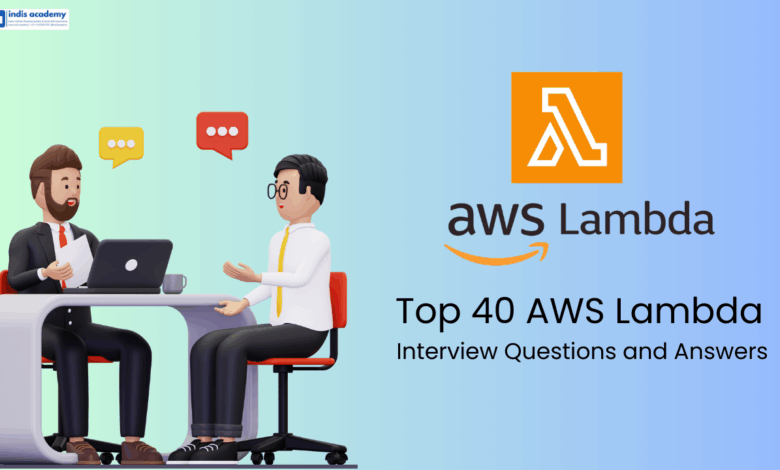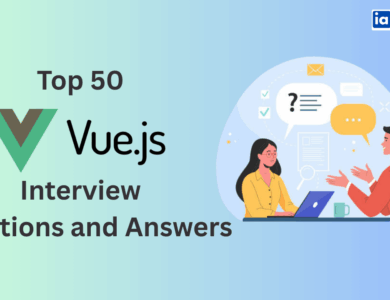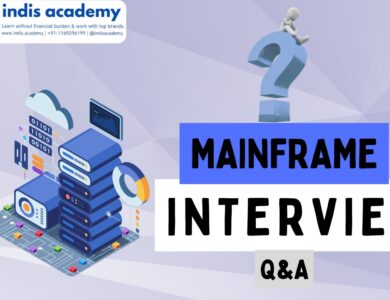Top 40 AWS Lambda Interview Questions and Answers
Prepare for your next cloud or DevOps interview with these top AWS Lambda interview questions and expert answers. Covers key concepts, architecture, real-world use cases, and troubleshooting tips.

Serverless computing is transforming the way modern applications are developed. It removes the burden of server management, reduces costs, and enables developers to focus on writing business logic instead of worrying about infrastructure.
One of the most widely used serverless platforms is AWS Lambda.
AWS Lambda allows developers to run code in response to triggers—like HTTP requests, file uploads, or database changes—without provisioning or managing servers. With support for multiple languages, automatic scaling, and deep integration with AWS services, Lambda has become essential for anyone building event-driven, microservice-based, or real-time applications in the cloud.
Whether you’re a developer, DevOps engineer, or cloud architect, understanding Lambda is a must-have skill for cloud interviews. In this guide, we’ve compiled the top 40 AWS Lambda interview questions—covering basic concepts, architecture, integrations, performance, and real-world scenarios—to help you ace your next job interview.
Learn More:
- Top 50 AWS DevOps Interview Questions and Answers
- Top Functional Testing Interview Questions and Answers – Crack Your QA Interview with Confidence
- Essential Mainframe Interview Questions – Tips and 50 Key Questions to Succeed
- 50+ SEO Interview Question to Crack Any SEO Interview
Interview Questions and Answers:
Q1. What is AWS Lambda?
Answer: AWS Lambda is a serverless compute service from Amazon Web Services that lets you run code in response to events without provisioning or managing servers. You only pay for the compute time you consume.
Q2. What are the key benefits of using Lambda?
Answer:
- No server management
- Scales automatically
- Cost-effective (pay-per-use)
- Integrates with 200+ AWS services
- Supports multiple languages (Node.js, Python, Java, Go, etc.)
Q3. What languages are supported by AWS Lambda?
Answer: As of 2025, AWS Lambda supports:
- Node.js
- Python
- Java
- Go
- Ruby
- .NET Core
- Custom runtimes using Lambda Runtime API
Q4. How is AWS Lambda billed?
Answer: You are billed based on:
- Number of requests
- Duration of execution (in milliseconds)
- Amount of memory allocated
Q5. What is the maximum timeout for a Lambda function?
Answer: The maximum timeout is 15 minutes (900 seconds).
Q6. Can AWS Lambda functions run continuously like background services?
Answer: No. Lambda is designed for short-lived executions. For background processing, AWS recommends Step Functions, SQS polling with Lambda, or ECS/Fargate.
Q7. What is a trigger in Lambda?
Answer: A trigger is an event source that invokes the Lambda function. Examples include:
- HTTP requests via API Gateway
- S3 uploads
- DynamoDB table updates
- CloudWatch scheduled events
Q8. How does Lambda scale?
Answer: Lambda scales automatically and concurrently. Each new event triggers a new instance of your function without requiring manual intervention.
Q9. What is the default memory allocated to a Lambda function?
Answer: By default, Lambda functions start with 128 MB of memory, configurable up to 10 GB in 1 MB increments.
Q10. What’s the difference between synchronous and asynchronous invocation in Lambda?
Answer:
- Synchronous: Caller waits for the response (e.g., API Gateway).
- Asynchronous: Function is invoked, and control is returned immediately (e.g., S3, SNS).
🔹 Section 2: Lambda Architecture & Configuration (Q11–Q20)
Q11. What are the core components of a Lambda function?
Answer:
- Function code
- Event source
- Runtime environment
- Execution role (IAM role)
- Environment variables
Q12. What is a cold start in AWS Lambda?
Answer: A cold start happens when Lambda initializes a new environment to handle an incoming request. This adds startup latency. Cold starts are more common for infrequently used or VPC-enabled functions.
Q13. How can you reduce cold start latency?
Answer:
- Use smaller packages
- Avoid VPC unless needed
- Use provisioned concurrency
- Keep functions warm with scheduled events
Q14. What is provisioned concurrency in Lambda?
Answer: Provisioned concurrency keeps a specified number of Lambda instances pre-initialized to reduce latency for critical applications.
Q15. What are environment variables in Lambda?
Answer: Key-value pairs used to pass configuration settings into the function without hardcoding values.
Q16. What is the AWS Lambda execution role?
Answer: It’s an IAM role that grants the Lambda function permission to access AWS resources (e.g., S3, CloudWatch).
Q17. Can Lambda functions be versioned?
Answer: Yes. Lambda supports versions and aliases, allowing you to deploy and manage multiple stages of your function (like dev, test, prod).
Q18. How do you manage code dependencies in Lambda?
Answer: You can:
- Package dependencies with the function code
- Use Lambda Layers to share libraries across multiple functions
- Use container images for complex dependencies
Q19. What is a Lambda Layer?
Answer: A Lambda Layer is a ZIP archive containing libraries or code that can be reused across multiple functions, helping reduce duplication.
Q20. What is the maximum deployment size for Lambda?
Answer:
- 50 MB for a zipped .zip file (direct upload)
- 250 MB unzipped (including Layers)
- 10 GB for container images (if using container support)
Q21. How does AWS Lambda integrate with API Gateway?
Answer:
API Gateway acts as a front door for applications, exposing REST or HTTP APIs. When integrated with Lambda, it forwards HTTP requests to your Lambda function, enabling you to build serverless REST APIs. API Gateway handles request routing, authorization, throttling, and response formatting.
Q22. How does Lambda integrate with S3?
Answer:
S3 can trigger Lambda functions on events such as:
- Object created (
s3: ObjectCreated:*) - Object deleted (
s3: ObjectRemoved:*)
This is used for real-time file processing, like resizing images, virus scanning, or extracting metadata.
Q23. Can Lambda be triggered by DynamoDB?
Answer:
Yes. DynamoDB Streams can trigger Lambda functions whenever changes (insert/update/delete) occur in the table. This is useful for audit logs, real-time analytics, or triggering business workflows.
Q24. What are AWS Step Functions and how do they work with Lambda?
Answer:
Step Functions let you build serverless workflows by chaining multiple Lambda functions. You can define sequences, parallel executions, and retries. It’s ideal for multi-step processes like order fulfillment or approval workflows.
Q25. How do you use Lambda with Amazon Event Bridge?
Answer:
Event Bridge can route custom or AWS service events to Lambda functions. It’s used for building event-driven applications, e.g., triggering functions on EC2 state changes or custom business events.
Q26. What is the use of Lambda in CI/CD pipelines?
Answer:
Lambda can automate tasks in deployment pipelines, such as:
- Validating code
- Notifying on deploy status
- Cleaning temporary files
Lambda integrates with CodePipeline, CodeBuild, and GitHub Actions via event triggers.
Q27. What is the difference between Lambda and Fargate?
Answer:
- Lambda: For event-driven, short-lived functions (max 15 mins)
- Fargate: For containerized applications, long-running tasks
Use Lambda for stateless, trigger-based functions, and Fargate for containerized workloads with more control.
Q28. Can Lambda connect to an RDS or VPC resource?
Answer:
Yes, but the Lambda function must be configured to run inside a VPC and be attached to the correct subnets and security groups. Note: This can introduce cold start latency.
Q29. How does SNS integrate with Lambda?
Answer:
Simple Notification Service (SNS) can trigger Lambda functions when a new message is published to a topic. It’s commonly used in pub-sub systems and event-driven notifications.
Q30. What is a dead-letter queue (DLQ) in Lambda?
Answer:
A DLQ (usually SQS or SNS) captures failed Lambda events. If a function invocation fails after all retry attempts, the event is sent to the DLQ for manual inspection or reprocessing.
Q31. How do you monitor a Lambda function’s performance?
Answer:
Use Amazon CloudWatch to monitor:
- Invocations
- Duration
- Errors
- Throttles
You can also create custom metrics, set alarms, and view logs with console.log ()(Node.js) or print ()(Python).
Q32. What are common Lambda errors and how to fix them?
Answer:
- Timeouts: Increase timeout setting or optimize logic
- Permission denied: Check IAM role policies
- Memory errors: Allocate more memory or optimize code
- Handler not found: Ensure correct file name and function path
Q33. How do retries work in AWS Lambda?
Answer:
- Synchronous triggers (e.g., API Gateway): No automatic retry
- Asynchronous triggers (e.g., S3, SNS): Retries up to 2 times with delays
Use DLQ or destination to manage failed events.
Q34. How do you debug Lambda functions locally?
Answer:
Use the AWS SAM CLI, Serverless Framework, or Docker containers to simulate Lambda execution locally with test events. You can also test functions directly from the AWS console.
Q35. What is X-Ray and how does it work with Lambda?
Answer:
AWS X-Ray helps trace and visualize requests through your serverless applications. It shows:
- Latency
- Call graphs
- Bottlenecks
Enable X-Ray tracing in Lambda settings for deeper observability.
Q36. Describe how you’d build a serverless image processing service using Lambda.
Answer:
- User uploads image to S3
- S3 triggers Lambda
- Lambda resizes or watermarks image
- Stores processed image back to S3 or CDN
Optional: Send a completion notification via SNS or Email
Q37. How would you use Lambda to automate report generation every day at midnight?
Answer:
Use Amazon Event Bridge (formerly CloudWatch Events) to create a scheduled rule ( cron expression) that triggers the Lambda function daily at 00:00.
Q38. How do you handle secrets securely in a Lambda function?
Answer:
- Store secrets in AWS Secrets Manager or SSM Parameter Store
- Retrieve them securely within the function
- Avoid hardcoding sensitive data in environment variables or code
Q39. How would you design a fault-tolerant serverless API with Lambda?
Answer:
- Use API Gateway with throttling and request validation
- Connect to Lambda with retry policies
- Integrate with Step Functions for multi-step logic
- Add DLQs for error handling
- Monitor via CloudWatch Alarms
Q40. What are the best practices for securing AWS Lambda functions?
Answer:
- Follow least privilege principle in IAM
- Enable VPC access only when needed
- Use environment variable encryption
- Audit with CloudTrail
- Use code signing to verify function integrity
Conclusion
AWS Lambda is at the heart of modern, event-driven cloud architectures. Its ability to run code without managing servers opens the door to powerful, scalable, and cost-effective solutions. Whether you’re building APIs, processing streams, or automating workflows—Lambda is a skill every cloud professional should master.
This guide covered the top 40 AWS Lambda interview questions and answers to help you prepare confidently and showcase both your technical understanding and real-world problem-solving abilities.
Keep learning, building, and experimenting—because serverless is the future.





